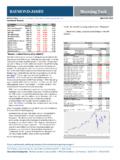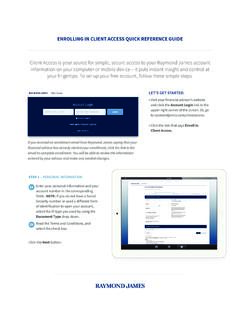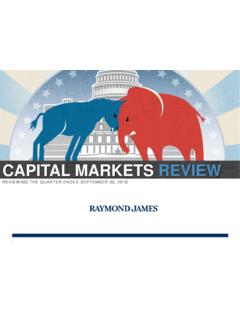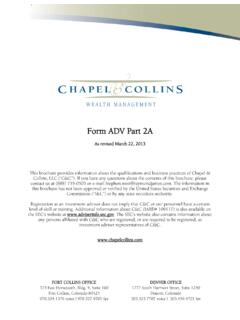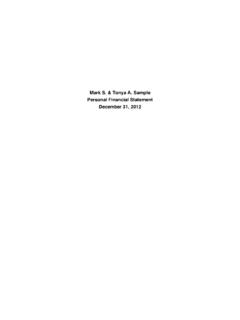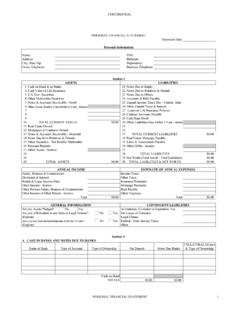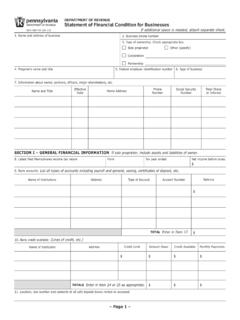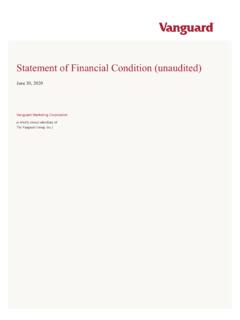Transcription of STATEMENT OF FINANCIAL CONDITION - raymondjames.com
1 Raymond James & Associates, OFFINANCIAL CONDITIONRAYMOND JAMES & ASSOCIATES, INC.(a wholly owned subsidiary of Raymond James FINANCIAL , Inc.) STATEMENT OF FINANCIAL CONDITION (Unaudited)$ in millions, except per share amountMarch 31, 2021 Assets:Cash and cash equivalents$ 2,560 Assets segregated pursuant to regulations ($5,250 at fair value) 9,011 Collateralized agreements 404 FINANCIAL instruments, at fair value:Trading assets ($363 pledged as collateral) 541 Derivative assets 54 Other investments ($7 pledged as collateral) 71 Brokerage client receivables, net 2,229 Receivables from brokers, dealers and clearing organizations, net 211 Other receivables, net 413 Loans to FINANCIAL advisors, net 680 Property and equipment, net 395 Deferred income taxes, net 28 Goodwill and identifiable intangible assets, net 348 Other assets 412 Total assets$ 17,357 Liabilities and stockholder s equity:Collateralized financings$ 278 FINANCIAL instrument liabilities, at fair value.
2 Trading liabilities 209 Derivative liabilities 50 Brokerage client payables 10,738 Payables to brokers, dealers and clearing organizations 173 Accrued compensation, commissions and benefits 471 Payables to affiliates, net 1,241 Other payables 520 Other borrowings 11 Total liabilities 13,691 Commitments and contingencies (see Note 14)Stockholder s equity:Common stock; $.10 par value; 4,000,000 shares authorized; 1,083,500 shares issued and outstanding Additional paid-in capital 1,737 Retained earnings 1,929 Total stockholder s equity 3,666 Total liabilities and stockholder s equity$ 17,357 See accompanying Notes to STATEMENT of FINANCIAL CONDITION (Unaudited). 1 RAYMOND JAMES & ASSOCIATES, INC.(a wholly owned subsidiary of Raymond James FINANCIAL , Inc.)NOTES TO STATEMENT OF FINANCIAL CONDITION (Unaudited)March 31, 2021 NOTE 1 ORGANIZATION AND NATURE OF BUSINESSO rganizationRaymond James & Associates, Inc.
3 ( RJ&A, we, our, us, the firm or the Company ), a wholly owned subsidiary of Raymond James FINANCIAL , Inc. ( RJF or Parent ) is engaged in various FINANCIAL services activities, including providing investment management services for retail and institutional clients, the underwriting, distribution, trading and brokerage of equity and debt securities and clearing services for both affiliated and unaffiliated broker-dealers. Raymond James FINANCIAL Services, Inc. ( RJFS ) is an affiliate of RJ&A and is also a wholly owned subsidiary of RJF. RJ&A is registered with the Securities and Exchange Commission and is registered as a Municipal Advisor with the Municipal Securities Rulemaking Board. We are a member of the FINANCIAL Industry Regulatory Authority ( FINRA ), National Futures Association ( NFA ) and various exchanges. Through our membership in the NFA, we are regulated by the Commodity Futures Trading of presentationAccounting estimates and assumptionsWe conform to our Parent s fiscal year end of September 30.
4 The preparation of the STATEMENT of FINANCIAL CONDITION in conformity with United States ( ) generally accepted accounting principles ( GAAP ) requires us to make certain estimates and assumptions that affect the reported amounts of assets and liabilities as well as the disclosure of contingent assets and liabilities at the date of the STATEMENT of FINANCIAL CONDITION . Actual results could differ from those estimates and could have a material impact on the STATEMENT of FINANCIAL 2 SUMMARY OF SIGNIFICANT ACCOUNTING POLICIESCash and cash equivalentsOur cash equivalents include money market funds or highly liquid investments with original maturities of 3 months or less, other than those used for trading segregated pursuant to regulationsIn accordance with Rule 15c3-3 of the Securities Exchange Act of 1934, RJ&A, as a broker-dealer carrying client accounts, is subject to requirements to maintain cash or qualified securities in a segregated reserve account for the exclusive benefit of its clients.
5 The amounts included in Assets segregated pursuant to regulations on our STATEMENT of FINANCIAL CONDITION represent cash and cash equivalents and Treasuries on deposit in our segregated reserve accounts for regulatory purposes. Such securities are carried at fair value on our STATEMENT of FINANCIAL CONDITION . Collateralized agreements and financingsSecurities purchased under agreements to resell and securities sold under agreements to repurchaseWe purchase securities under short-term agreements to resell ( reverse repurchase agreements ). Additionally, we sell securities under agreements to repurchase ( repurchase agreements ). Both reverse repurchase agreements and repurchase agreements are accounted for as collateralized financings and are carried at contractual amounts plus accrued interest. We receive collateral with a fair value that is typically equal to or in excess of the principal amount loaned under reverse repurchase agreements to mitigate credit exposure.
6 To ensure that the market value of the underlying collateral remains sufficient, collateral values are evaluated on a daily basis, and collateral is obtained from or returned to the counterparty when contractually required. Under repurchase agreements, we are required to post collateral in an amount that typically exceeds the carrying value of these agreements. In the event that the market value of the securities we pledge as collateral declines, we may 2have to post additional collateral or reduce borrowing amounts. Reverse repurchase agreements and repurchase agreements are included in Collateralized agreements and Collateralized financings, respectively, on our STATEMENT of FINANCIAL CONDITION . See Note 5 for additional information regarding collateralized agreements and financings. Refer to the allowance for credit losses section below for further information related to our allowance for credit losses related to collateralized borrowed and securities loanedWe act as an intermediary between broker-dealers and other FINANCIAL institutions whereby we borrow securities from one broker-dealer and then either lend them to another broker-dealer or use them to cover short positions.
7 Where permitted, we have also loaned, to broker-dealers and other FINANCIAL institutions, securities owned by the firm, our clients, or others we have received as collateral. Both securities borrowed and securities loaned transactions are accounted for as collateralized financings and are recorded at the amount of cash advanced or received. In securities borrowed transactions, we are required to deposit cash with the lender in an amount which is generally in excess of the market value of securities borrowed. With respect to securities loaned, we generally receive cash in an amount in excess of the market value of securities loaned. We evaluate the market value of securities borrowed and loaned on a daily basis, with additional collateral obtained or refunded as necessary. Securities borrowed and securities loaned are included in Collateralized agreements and Collateralized financings, respectively, on our STATEMENT of FINANCIAL CONDITION .
8 See Note 5 for additional information regarding collateralized agreements and financings. Refer to the allowance for credit losses section below for further information related to our allowance for credit losses related to collateralized agreements. FINANCIAL instruments, FINANCIAL instrument liabilities, at fair value FINANCIAL instruments and FINANCIAL instrument liabilities are recorded at fair value. Fair value is defined by GAAP as the price that would be received to sell an asset or paid to transfer a liability (an exit price) in an orderly transaction between market participants at the measurement date in the principal or most advantageous market for the asset or determining the fair value of our FINANCIAL instruments in accordance with GAAP, we use various valuation approaches, including market and/or income approaches. Fair value is a market-based measurement considered from the perspective of a market participant.
9 As such, our fair value measurements reflect assumptions that we believe market participants would use in pricing the asset or liability at the measurement date. GAAP provides for the following three levels to be used to classify our fair value 1 - FINANCIAL instruments included in Level 1 are highly liquid instruments valued using unadjusted quoted prices in active markets for identical assets or 2 - FINANCIAL instruments reported in Level 2 include those that have pricing inputs that are other than unadjusted quoted prices in active markets, but which are either directly or indirectly observable as of the reporting date ( , prices for similar instruments).Level 3 - FINANCIAL instruments reported in Level 3 have little, if any, market activity and are measured using one or more inputs that are significant to the fair value measurement and unobservable. These valuations require judgment or estimation.
10 These instruments are generally valued using discounted cash flow requires that we maximize the use of observable inputs and minimize the use of unobservable inputs when performing our fair value measurements. The availability of observable inputs can vary from instrument to instrument and in certain cases, the inputs used to measure fair value may fall into different levels of the fair value hierarchy. In such cases, an instrument s level within the fair value hierarchy is based on the lowest level of input that is significant to the fair value measurement. Our assessment of the significance of a particular input to the fair value measurement of an instrument requires judgment and consideration of factors specific to the techniques and inputsThe fair values for certain of our FINANCIAL instruments are derived using pricing models and other valuation techniques that involve management judgment.

